Meeting of the Board of Regents | September 2009
|
|
|
|
TO: |
|
|
FROM: |
Johanna Duncan-Poitier |
|
SUBJECT: |
Graduation Rate - Part III: Continuation of Discussion on Policy Decisions
|
|
DATE: |
September 4, 2009 |
|
STRATEGIC GOAL: |
Goals 1 and 2 |
|
AUTHORIZATION(S): |
|
SUMMARY
Issue(s) for Discussion
This month the Board of Regents will continue their discussions on graduation requirements and begin a more in-depth discussion of three policy questions.
- Do the Regents wish to continue to implement the phase-out of the local diploma for general education students?
- When do the Regents want to begin using the federal four-year adjusted rate graduation cohort definition?
- Do the Regents want to use an extended-year adjusted cohort graduation rate (or rates) in order to give schools and districts credit for students who take longer than four years to graduate?
Reason(s) for Consideration
Review of Policy.
Procedural History
In May 2009, the Board of Regents began its discussion about graduation requirements and assessing whether New York should increase the graduation rate goal. In June 2009, the Regents continued this discussion by examining the most recent graduation rate data for the 2004 cohort, comparisons to other recent cohort data and the impact of the Regents 2005 policy decision to phase-out the local diploma option for general education students. The Regents also discussed the new federal No Child Left Behind (NCLB) accountability requirements concerning the establishment of a new graduation rate goal, annual targets, and using disaggregated graduation rate data. In July 2009, the Regents received an information item which included a compilation of issues and additional data that the Regents requested to inform their ongoing discussion on the policy decisions concerning graduation rate that they will need to make before the end of 2009. Some of the data requested by the Regents in June was also provided in the July item, including the explanation of the phase-out of the local diploma and an illustration of how New York’s current cohort definition works and the differences in the new federal cohort definition that all states must begin using.
Background Information
Graduation rate accountability determinations about schools and districts are based upon whether or not a school or district has met the graduation rate goal established by the State, or, alternatively, whether or not the school or district has met the established annual graduation rate target. The annual target(s) establish the degree of continuous and substantial improvement the student accountability groups that have not yet reached the graduation rate goal must make each year toward the goal. If the school or district has not met either the graduation rate goal or the annual target for two consecutive years it has not made Adequate Yearly Progress (AYP) in those years and is identified as in need of improvement.
New federal NCLB accountability regulations require that beginning with 2011-2012 school year results, schools and districts are accountable not only for an aggregate graduation rate for the school/district, but also for whether or not all student groups have met either the graduation rate goal or annual target. When establishing a new graduation rate goal and annual targets, states must take into consideration how they will be applied to all student subgroups and how the new rules about the disaggregation of graduation rate data will impact on the number of schools and districts that may be identified as not making AYP. In addition to the new NCLB requirements, IDEA requires states to establish measurable and rigorous targets for graduation rates for students with disabilities, using the same annual graduation rate targets as established under NCLB. The Department considers a school district’s graduation rates in relation to the State’s targets in its determination of whether a school district, "needs assistance" or "needs intervention" under IDEA.
The six policy decisions related to graduation rate that the Board of Regents indicated that they will need to make during the fall of 2009 are:
- Do the Regents wish to continue to implement the phase-out of the local diploma for general education students?
- When do the Regents want to begin using the federal four-year adjusted rate graduation cohort definition?
- Do the Regents want to use an extended-year adjusted cohort graduation rate (or rates) in order to give schools and districts credit for students who take longer than four years to graduate?
- Do the Regents want to set a rigorous “aspirational” graduation rate goal and a separate accountability graduation rate goal and annual target(s)?
- How rigorous do the Regents want the accountability graduation rate goal and annual target(s) to be?
- Should the current “safety net’ for students with disabilities be extended beyond the 2009 student cohort?
Issues for Discussion this Month
The Regents will review the additional data requested and begin a more in-depth discussion of the first three policy questions above.
Background information including responses to specific questions posed by members of the Board of Regents (indicated in bold and italics) on these three issues for the September discussion is provided in this item. Relevant background information has been provided in previous Regents items on Graduation Rate and is repeated in this item for easy reference. The specific data requests made by members of the Board of Regents in June were:
- What were the specific requirements for receipt of local diplomas by students in cohorts prior to 2004? How does the phase-out of the local diploma for general education students work? (Provided in July and in this item.)
- What is the breakdown of performance for students who have not received a Regents Diploma because they did not pass the Regents examinations with scores of at least 65? How are students performing on the various required Regents examinations? (Provided in this item.)
- What does the current data show about eliminating the local diploma for general education students? (Provided in this item.)
- What does a total cohort picture look like for a district? (Provided in July and in this item.)
- How is a cohort defined now? How are dropouts and transfers counted? What will be the impact of the new federal cohort definition? (Provided in July and in this item.)
- How does the use of an extended-year cohort(s) for accountability purposes impact the graduation rate? (Provided in this item.)
- How many students are in the student groups for which schools would not make Adequate Yearly Progress (AYP)? (Will be provided for discussion on setting graduation rate goal and annual targets – compilation is underway.)
Policy Decision #1: Do the Regents wish to continue to implement the phase-out of the local diploma for general education students?
Background Information
In New York State, for purposes of school and district accountability, the definition of a high school graduate includes students who complete high school with a local diploma, Regents diploma or Regents diploma with Advanced Designation. Students who receive a General Equivalency Diploma (GED) or an individualized education program (IEP) diploma are not considered graduates for this purpose.
What were the specific requirements for receipt of local diplomas by students in cohorts prior to 2004? How does the phase-out of the local diploma for general education students work?
Passage of Regents Competency Tests (RCTs) to meet the requirements for a local diploma was completely phased-out for general education students after the 1998 cohort. In order to receive a local diploma, students in the 1999 - 2004 cohorts (students who entered 9th grade in September 1999, 2000, 2001, 2002, 2003 or 2004) had to earn at least 22 units of credit and had to pass five required Regents exams with scores of 55 or higher.
In 2005, the Regents enacted regulations that would phase-out the local diploma for general education students. The phase-out will be complete with the 2008 cohort (students who entered 9th grade in 2008). This means that general education students in the 2008 cohort will be required to pass all required Regents exams with scores of at least 65.
The phase-out of the local diploma works as follows:
- Students in the 2004 cohort can receive a local diploma by earning 22 units of credit and scoring 55 or higher on the required five Regents exams.
- Students in the 2005 cohort (students who entered 9th grade in September 2005) are required to pass at least two of the five required Regents exams with a score of at least 65 and pass the remaining exams with a score of 55 or higher.
- Students in the 2006 cohort (students who entered 9th grade in September 2006) are required to pass at least three of the five required Regents exams with a score of at least 65 and pass the remaining exams with a score of 55 or higher.
- Students in the 2007 cohort (students who entered 9th grade in September 2007) are required to pass at least four of the five required Regents exams with a score of at least 65 and pass the remaining exams with a score of 55 or higher.
- The planned phase-out will be complete beginning with general education students who entered ninth grade in 2008. In order to graduate from high school, general education students in the 2008 cohort and future cohorts will have to receive either a Regents diploma or a Regents Diploma with Advanced Designation. To receive a Regents diploma, these students must score 65 or above on all five required Regents exams and earn 22 units of credit. To receive a Regents diploma with Advanced Designation, general education students must score 65 or above on eight required Regents exams and earn 22 units of credit.
What is the breakdown of performance for students who have not received a Regents Diploma because they did not pass the Regents examinations with scores of at least 65? How are students performing on the various required Regents examinations?
Students in the 2003 Total Cohort Who Earned Local Diplomas After 5 Years
by Number of Required Regents Examinations in the 55-64 Score Range
|
Number of Regents exams with score between 55 and 64 |
General education students |
Students with disabilities |
Total students |
Local Diplomas Awarded - general education |
Local Diplomas Awarded - Students with disabilities |
Local Diplomas Awarded - All Students |
Percent of All Local Diplomas Awarded - general education |
Percent of All Local Diplomas Awarded - Students with disabilities |
Percent of Local Diplomas - All Students |
|
1 |
9,717 |
2,663 |
12,380 |
25,545 |
7,281 |
32,826 |
38% |
37% |
38% |
|
2 |
6,425 |
1,810 |
8,235 |
25,545 |
7,281 |
32,826 |
25% |
25% |
25% |
|
3 |
3,848 |
857 |
4,705 |
25,545 |
7,281 |
32,826 |
15% |
12% |
14% |
|
4 |
1,638 |
273 |
1,911 |
25,545 |
7,281 |
32,826 |
6% |
4% |
6% |
|
5 |
395 |
46 |
441 |
25,545 |
7,281 |
32,826 |
2% |
1% |
1% |
|
Total |
22,023 |
5,649 |
27,672 |
25,545* |
7,281 |
32,826 |
86%** |
78% |
84% |
* Some general education students can take and pass RCTs instead of Regents Exams. This is true for those general education students who are not classified as special education students but are considered eligible under federal law for testing accommodations. Included in this category are students who are declassified from special education at some point during high school.
** This column shows, for example, that 38% of the students who get a local diploma pass only one Regents exam with a score between 55-64; by contrast, only 2% of the students who get a local diploma pass all five Regents exams with a score of 55-64.
Students in the 2004 Total Cohort Who Earned Local Diplomas After 4 Years
by Number of Required Regents Examinations in the 55-64 Score Range
|
Number of Regents exams with score between 55 and 64 |
General education students |
Students with disabilities |
Total students |
Local Diplomas Awarded - general Education |
Local Diplomas Awarded - students with disabilities |
Local Diplomas Awarded - All Students |
Percent of Local Diplomas - general education |
Percent of Local Diplomas - students with disabilities |
Percent of Local Diplomas – All Student |
|
1 |
7,848 |
2,393 |
10,241 |
19,269 |
6,507 |
25,776 |
41% |
37% |
40% |
|
2 |
4,905 |
1,675 |
6,580 |
19,269 |
6,507 |
25,776 |
25% |
26% |
26% |
|
3 |
2,599 |
791 |
3,390 |
19,269 |
6,507 |
25,776 |
13% |
12% |
13% |
|
4 |
1,085 |
240 |
1,325 |
19,269 |
6,507 |
25,776 |
6% |
4% |
5% |
|
5 |
197 |
43 |
240 |
19,269 |
6,507 |
25,776 |
1% |
1% |
1% |
|
Total |
16,634 |
5,142 |
21,776 |
19,269* |
6,507 |
25,776 |
86%** |
79% |
84% |
* Some general education students can take and pass RCTs instead of Regents Exams. This is true for those general education students who are not classified as special education students but are considered eligible under federal law for testing accommodations. Included in this category are students who are declassified from special education at some point during high school.
The charts below show performance in the 55 to 64 score range for students who earned local diplomas in the 2003 Total cohort after five years and the 2004 total cohort after four years. The chart shows the counts of students by subject area, for students who scored between 55 and 64 in one of the five required assessments, in two of the five assessment areas, etc.
Students in the 2003 Total Cohort Who Earned Local Diplomas After 5 Years
by Number and Subject of Required Regents Examinations in the 55-64 Score Range
|
Number of required Regents exams with score of 55 - 64 |
Examination |
General Education Students |
Students with Disabilities |
All Students |
Percentage of Total |
||
|
General Education Students |
Students with Disabilities |
All Students |
|||||
|
1 |
ELA |
1,378 |
474 |
1,852 |
14% |
18% |
15% |
|
1 |
Global History |
3,254 |
704 |
3,958 |
33% |
26% |
32% |
|
1 |
Mathematics |
1,575 |
602 |
2,177 |
16% |
23% |
18% |
|
1 |
Science |
1,804 |
462 |
2,266 |
19% |
17% |
18% |
|
1 |
US History |
1,706 |
421 |
2,127 |
18% |
16% |
17% |
|
|
Total 55-64: 1 exam |
9,717 |
2,663 |
12,380 |
|
|
|
|
2 |
ELA |
1,776 |
665 |
2,441 |
14% |
18% |
15% |
|
2 |
Global History |
3,750 |
920 |
4,670 |
29% |
25% |
28% |
|
2 |
Mathematics |
1,992 |
672 |
2,664 |
16% |
19% |
16% |
|
2 |
Science |
2,682 |
682 |
3,364 |
21% |
19% |
20% |
|
2 |
US History |
2,650 |
681 |
3,331 |
21% |
19% |
20% |
|
|
Total 55-64: 2 exams |
12,850 |
3,620 |
16,470 |
|
|
|
|
3 |
ELA |
1,812 |
476 |
2,288 |
16% |
19% |
16% |
|
3 |
Global History |
2,927 |
622 |
3,549 |
25% |
24% |
25% |
|
3 |
Mathematics |
1,895 |
445 |
2,340 |
16% |
17% |
17% |
|
3 |
Science |
2,497 |
503 |
3,000 |
22% |
20% |
21% |
|
3 |
US History |
2,413 |
525 |
2,938 |
21% |
20% |
21% |
|
|
Total 55-64: 3 exams |
11,544 |
2,571 |
14,115 |
|
|
|
|
4 |
ELA |
1,127 |
200 |
1,327 |
17% |
18% |
17% |
|
4 |
Global History |
1,458 |
236 |
1,694 |
22% |
22% |
22% |
|
4 |
Mathematics |
1,202 |
224 |
1,426 |
18% |
21% |
19% |
|
4 |
Science |
1,386 |
210 |
1,596 |
21% |
19% |
21% |
|
4 |
US History |
1,379 |
222 |
1,601 |
21% |
20% |
21% |
|
|
Total 55-64: 4 exams |
6,552 |
1,092 |
7,644 |
|
|
|
|
5 |
ELA |
395 |
46 |
441 |
na |
na |
na |
|
5 |
Global History |
395 |
46 |
441 |
na |
na |
na |
|
5 |
Mathematics |
395 |
46 |
441 |
na |
na |
na |
|
5 |
Science |
395 |
46 |
441 |
na |
na |
na |
|
5 |
US History |
395 |
46 |
441 |
na |
na |
na |
|
|
Total 55-64: 5 exams |
1,975 |
230 |
2,205 |
|
|
|
Students in the 2004 Total Cohort Who Earned Local Diplomas After 4 Years
by Number and Subject of Required Regents Examinations in the 55-64 Score Range
|
Number of required Regents exams with score of |
Examination |
General Education Students |
Students with Disabilities |
All Students |
Percentage of Total |
||
|
General Education Students |
Students with Disabilities |
All Students |
|||||
|
1 |
ELA |
881 |
469 |
1,350 |
11% |
20% |
13% |
|
1 |
Global History |
3,145 |
552 |
3,697 |
40% |
23% |
36% |
|
1 |
Mathematics |
1,095 |
531 |
1,626 |
14% |
22% |
16% |
|
1 |
Science |
1,598 |
455 |
2,053 |
20% |
19% |
20% |
|
1 |
US History |
1,129 |
386 |
1,515 |
14% |
16% |
15% |
|
|
Total 55-64: |
7,848 |
2,393 |
10,241 |
|
|
|
|
2 |
ELA |
1,202 |
598 |
1,800 |
12% |
18% |
14% |
|
2 |
Global History |
3,081 |
821 |
3,902 |
31% |
25% |
30% |
|
2 |
Mathematics |
1,331 |
640 |
1,971 |
14% |
19% |
15% |
|
2 |
Science |
2,104 |
654 |
2,758 |
21% |
20% |
21% |
|
2 |
US History |
2,092 |
637 |
2,729 |
21% |
19% |
21% |
|
|
Total 55-64: |
9,810 |
3350 |
13,160 |
|
|
|
|
3 |
ELA |
1,126 |
443 |
1,569 |
14% |
19% |
15% |
|
3 |
Global History |
2,064 |
545 |
2,609 |
26% |
23% |
26% |
|
3 |
Mathematics |
1,199 |
416 |
1,615 |
15% |
18% |
16% |
|
3 |
Science |
1,762 |
488 |
2,250 |
23% |
21% |
22% |
|
3 |
US History |
1,646 |
481 |
2,127 |
21% |
20% |
21% |
|
|
Total 55-64: |
7,797 |
2,373 |
10,170 |
|
|
|
|
4 |
ELA |
748 |
185 |
933 |
17% |
19% |
18% |
|
4 |
Global History |
960 |
201 |
1,161 |
22% |
21% |
22% |
|
4 |
Mathematics |
818 |
185 |
1,003 |
19% |
19% |
19% |
|
4 |
Science |
930 |
197 |
1,127 |
21% |
21% |
21% |
|
4 |
US History |
884 |
192 |
1,076 |
20% |
20% |
20% |
|
|
Total 55-64: |
4,340 |
960 |
5,300 |
|
|
|
|
5 |
ELA |
197 |
43 |
240 |
na |
na |
na |
|
5 |
Global History |
197 |
43 |
240 |
na |
na |
na |
|
5 |
Mathematics |
197 |
43 |
240 |
na |
na |
na |
|
5 |
Science |
197 |
43 |
240 |
na |
na |
na |
|
5 |
US History |
197 |
43 |
240 |
na |
na |
na |
|
|
Total 55-64: |
985 |
215 |
1,200 |
|
|
|
Students in the 2003 Total Cohort Who Earned Local Diplomas After 5 Years
|
pupiltype |
Subject Area |
Scored 55-64 On Regents |
Passed RCT |
Count of Students who earned local diplomas |
55-64 on Regents/Local Diplomas |
Passed RCT /Local Diplomas |
|
general education students |
ELA |
6,488 |
290 |
25,545 |
25% |
1% |
|
Global History |
11,784 |
223 |
25,545 |
46% |
1% |
|
|
Mathematics |
7,059 |
192 |
25,545 |
28% |
1% |
|
|
Science |
8,764 |
165 |
25,545 |
34% |
1% |
|
|
US History |
8,543 |
195 |
25,545 |
33% |
1% |
|
|
students with disabilities |
ELA |
1,861 |
2,330 |
7,281 |
26% |
32% |
|
Global History |
2,528 |
1,795 |
7,281 |
35% |
25% |
|
|
Mathematics |
1,989 |
1,883 |
7,281 |
27% |
26% |
|
|
Science |
1,903 |
1,599 |
7,281 |
26% |
22% |
|
|
US History |
1,895 |
1,582 |
7,281 |
26% |
22% |
|
|
all students |
ELA |
8,349 |
2,620 |
32,826 |
25% |
8% |
|
Global History |
14,312 |
2,018 |
32,826 |
44% |
6% |
|
|
Mathematics |
9,048 |
2,075 |
32,826 |
28% |
6% |
|
|
Science |
10,667 |
1,764 |
32,826 |
32% |
5% |
|
|
US History |
10,438 |
1,777 |
32,826 |
32% |
5% |
Students in the 2004 Total Cohort Who Earned Local Diplomas After 4 Years
|
|
Subject |
Scored 55-64 On Regents |
Passed RCT |
Count of Students who earned local diplomas |
55-64 on Regents/Local Diplomas |
Passed RCT /Local Diplomas |
|
General Education Students |
ELA |
4,154 |
127 |
19,269 |
22% |
1% |
|
Global History |
9,447 |
182 |
19,269 |
49% |
1% |
|
|
Mathematics |
4,640 |
89 |
19,269 |
24% |
0% |
|
|
Science |
6,591 |
75 |
19,269 |
34% |
0% |
|
|
US History |
5,948 |
115 |
19,269 |
31% |
1% |
|
|
Students with Disabilities |
ELA |
1,738 |
1,685 |
6,507 |
27% |
26% |
|
Global History |
2,162 |
1,661 |
6,507 |
33% |
26% |
|
|
Mathematics |
1,815 |
1,425 |
6,507 |
28% |
22% |
|
|
Science |
1,837 |
1,138 |
6,507 |
28% |
17% |
|
|
US History |
1,739 |
1,157 |
6,507 |
27% |
18% |
|
|
All Students |
ELA |
5,892 |
1,812 |
25,776 |
23% |
7% |
|
Global History |
11,609 |
1,843 |
25,776 |
45% |
7% |
|
|
Mathematics |
6,455 |
1,514 |
25,776 |
25% |
6% |
|
|
Science |
8,428 |
1,213 |
25,776 |
33% |
5% |
|
|
US History |
7,687 |
1,272 |
25,776 |
30% |
5% |
Regents Examination Performance in the 55-64 Score Range - Students in the 2003 Total Cohort Who Earned Local Diplomas After 5 Years
|
SCORE |
English Language Arts |
Global History |
Mathematics |
Science |
US History |
||||||||||
|
Count of Students |
frequency |
cumulative frequency |
Count of Students |
frequency |
cumulative frequency |
Count of Students |
frequency |
cumulative frequency |
Count of Students |
frequency |
cumulative frequency |
Count of Students |
frequency |
cumulative frequency |
|
|
55 |
1,407 |
17% |
17% |
3,034 |
21% |
21% |
977 |
11% |
11% |
1,257 |
12% |
12% |
2,371 |
23% |
23% |
|
56 |
641 |
8% |
25% |
2,364 |
17% |
38% |
1,080 |
12% |
23% |
1,456 |
14% |
25% |
1,640 |
16% |
38% |
|
57 |
1,561 |
19% |
43% |
1,049 |
7% |
45% |
963 |
11% |
33% |
1,182 |
11% |
37% |
410 |
4% |
42% |
|
58 |
918 |
11% |
54% |
2,039 |
14% |
59% |
836 |
9% |
43% |
1,267 |
12% |
48% |
1,982 |
19% |
61% |
|
59 |
1,612 |
19% |
74% |
1,686 |
12% |
71% |
963 |
11% |
53% |
1,154 |
11% |
59% |
1,341 |
13% |
74% |
|
60 |
451 |
5% |
79% |
1,421 |
10% |
81% |
1,062 |
12% |
65% |
1,083 |
10% |
69% |
303 |
3% |
77% |
|
61 |
848 |
10% |
89% |
618 |
4% |
85% |
1,011 |
11% |
76% |
1,081 |
10% |
79% |
1,056 |
10% |
87% |
|
62 |
318 |
4% |
93% |
1,121 |
8% |
93% |
1,022 |
11% |
87% |
1,201 |
11% |
91% |
836 |
8% |
95% |
|
63 |
567 |
7% |
100% |
609 |
4% |
97% |
789 |
9% |
96% |
724 |
7% |
98% |
252 |
2% |
98% |
|
64 |
26 |
0% |
100% |
371 |
3% |
100% |
345 |
4% |
100% |
262 |
2% |
100% |
247 |
2% |
100% |
|
total |
8,349 |
|
|
14,312 |
|
|
9,048 |
|
|
10,667 |
|
|
10,438 |
|
|
Regents Examination Performance in the 55-64 Score Range - Students in the 2004 Total Cohort Who Earned Local Diplomas After 4 Years
|
SCORE |
English Language Arts |
Global History |
Mathematics |
Science |
US History |
||||||||||
|
Count of Students |
frequency |
cumulative frequency |
Count of Students |
frequency |
cumulative frequency |
Count of Students |
frequency |
cumulative frequency |
Count of Students |
frequency |
cumulative frequency |
Count of Students |
frequency |
cumulative frequency |
|
|
55 |
376 |
6% |
6% |
2,462 |
21% |
21% |
468 |
7% |
7% |
1,214 |
14% |
14% |
1,542 |
20% |
20% |
|
56 |
960 |
16% |
23% |
1,329 |
11% |
33% |
814 |
13% |
20% |
978 |
12% |
26% |
668 |
9% |
29% |
|
57 |
465 |
8% |
31% |
1,963 |
17% |
50% |
690 |
11% |
31% |
907 |
11% |
37% |
1,328 |
17% |
46% |
|
58 |
1,231 |
21% |
51% |
1,289 |
11% |
61% |
534 |
8% |
39% |
1,003 |
12% |
49% |
1,320 |
17% |
63% |
|
59 |
1,165 |
20% |
71% |
914 |
8% |
69% |
731 |
11% |
50% |
738 |
9% |
57% |
504 |
7% |
70% |
|
60 |
285 |
5% |
76% |
1,371 |
12% |
80% |
785 |
12% |
62% |
998 |
12% |
69% |
807 |
10% |
80% |
|
61 |
711 |
12% |
88% |
1,042 |
9% |
89% |
793 |
12% |
75% |
867 |
10% |
80% |
714 |
9% |
90% |
|
62 |
199 |
3% |
92% |
745 |
6% |
96% |
781 |
12% |
87% |
867 |
10% |
90% |
318 |
4% |
94% |
|
63 |
496 |
8% |
100% |
223 |
2% |
98% |
606 |
9% |
96% |
623 |
7% |
97% |
407 |
5% |
99% |
|
64 |
4 |
0% |
100% |
271 |
2% |
100% |
253 |
4% |
100% |
233 |
3% |
100% |
79 |
1% |
100% |
|
total |
5,892 |
|
|
11,609 |
|
|
6,455 |
|
|
8,428 |
|
|
7,687 |
|
|
|
|
Credentials Awarded to Students in the 2003 Total Cohort Who Earned Diplomas After 5 Years
|
need/resource capacity category |
All Students |
General Education Students |
Students with Disabilities |
|||||||||
|
Graduates |
% Local diploma |
% Regents |
% Regents with advanced designation |
Graduates |
% Local diploma |
% Regents |
% Regents with advanced designation |
Graduates |
% Local diploma |
% Regents |
% Regents with advanced designation |
|
|
NYC |
46,265 |
35% |
40% |
25% |
43,828 |
33% |
41% |
26% |
2,437 |
80% |
17% |
3% |
|
Large city districts |
4,693 |
44% |
43% |
13% |
4,288 |
41% |
45% |
14% |
405 |
75% |
23% |
1% |
|
High need urban/suburban districts |
11,266 |
25% |
49% |
26% |
10,287 |
21% |
51% |
28% |
979 |
66% |
31% |
3% |
|
High need rural districts |
11,283 |
17% |
46% |
37% |
10,321 |
13% |
47% |
40% |
962 |
59% |
36% |
4% |
|
Average need districts |
59,850 |
11% |
42% |
47% |
54,501 |
8% |
42% |
51% |
5,349 |
50% |
43% |
6% |
|
Low need districts |
30,608 |
9% |
32% |
59% |
27,566 |
6% |
31% |
64% |
3,042 |
37% |
50% |
13% |
|
Charter schools |
134 |
53% |
47% |
0% |
116 |
47% |
53% |
0% |
18 |
94% |
6% |
0% |
|
Total Public |
164,099 |
20% |
40% |
40% |
150,907 |
17% |
41% |
43% |
13,192 |
55% |
38% |
7% |
Credentials Awarded to Students in the 2004 Total Cohort Who Earned Diplomas After 4 Years
|
need/resource capacity category |
All Students |
General Education Students |
Students with Disabilities |
|||||||||
|
Graduates |
% Local diploma |
% Regents |
% Regents with advanced designation |
Graduates |
% Local diploma |
% Regents |
% Regents with advanced designation |
Graduates |
% Local diploma |
% Regents |
% Regents with advanced designation |
|
|
NYC |
42,313 |
28% |
43% |
30% |
40,036 |
25% |
44% |
31% |
2,277 |
69% |
27% |
5% |
|
Large city districts |
4,457 |
39% |
45% |
15% |
4,033 |
36% |
47% |
17% |
424 |
71% |
27% |
2% |
|
High need urban/suburban districts |
10,322 |
21% |
50% |
29% |
9,398 |
17% |
52% |
31% |
924 |
63% |
34% |
3% |
|
High need rural districts |
10,917 |
16% |
44% |
39% |
10,038 |
13% |
44% |
42% |
879 |
55% |
41% |
4% |
|
Average need districts |
59,076 |
10% |
41% |
49% |
53,789 |
6% |
40% |
54% |
5,287 |
47% |
46% |
7% |
|
Low need districts |
31,236 |
9% |
31% |
61% |
28,112 |
6% |
28% |
66% |
3,124 |
35% |
51% |
14% |
|
Charter schools |
346 |
25% |
63% |
12% |
299 |
19% |
68% |
13% |
47 |
66% |
32% |
2% |
|
Total Public |
158,667 |
16% |
40% |
43% |
145,705 |
13% |
40% |
47% |
12,962 |
50% |
42% |
8% |
|
|
What will be the impact of eliminating the local diploma for general education students?
Sixteen percent of all students who graduated in June 2008 received a local diploma instead of the Regents or Advanced Regents Diploma.
- 33 percent of Black students received a local diploma
- 31 percent of Hispanic students received a local diploma
- 9.5 percent of Asian/Pacific Islander students received a local diploma
- 10 percent of White students received a local diploma
- 22 percent of American Indian/Alaskan Native students received a local diploma
- 48 percent of English Language Learners receive a local diploma
- 50 percent of students with disabilities received a local diploma
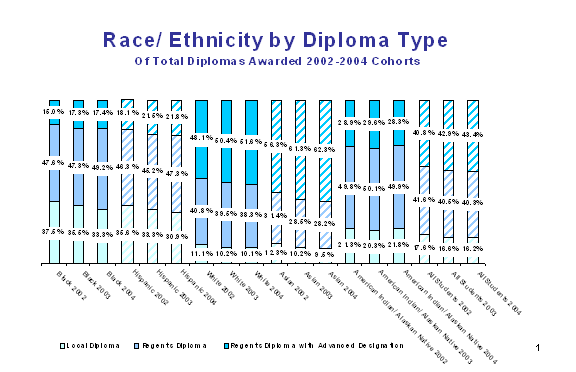
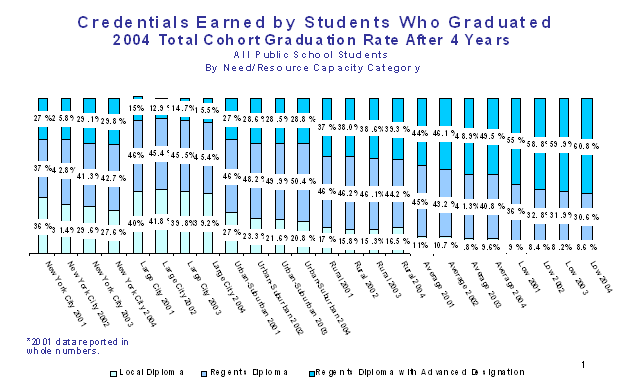
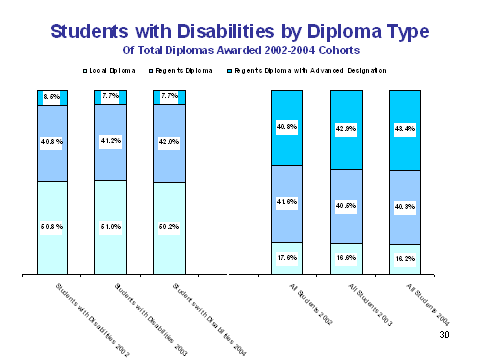
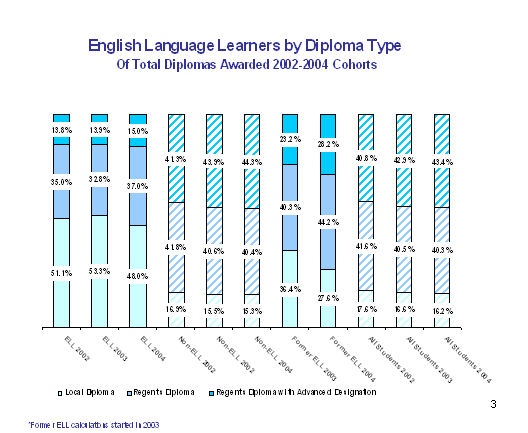
The charts below show the difference in the June 2008 graduation rate for the total student cohort if the local diploma had not been available in June 2008, and if none of the students who received a local diploma had received a Regents diploma instead:
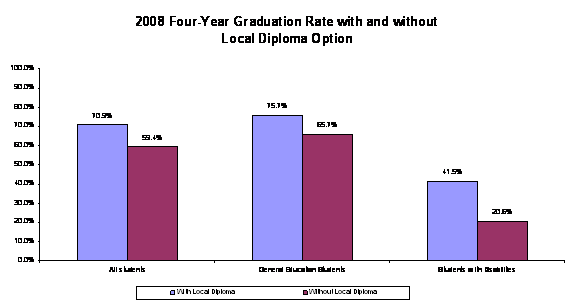
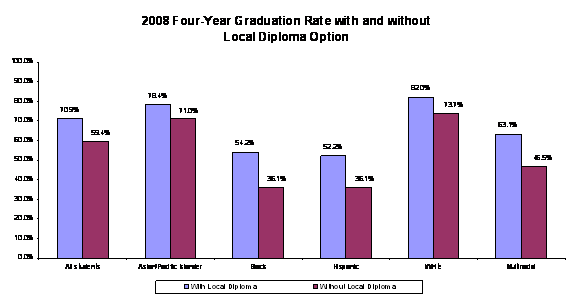
Policy Decision #2: When do the Regents want to begin using the federal four- year adjusted rate graduation cohort definition?
Background Information
How the graduation rate cohort is defined determines which students are being counted for accountability purposes. Beginning no later than with the 2011-2012 school year results, states must adopt the new federal four-year adjusted graduation rate cohort definition. New York’s current definition of the four-year cohort is very close to the proposed federal definition.
How does New York’s current cohort definition work? How are dropouts and transfers counted?
In making accountability decisions for schools and districts for the 2009-2010 school year, New York will use the results of the 2004 graduation-rate cohort. This cohort is defined as follows:
The 2004 graduation-rate cohort includes all students as of June 30, 2008, regardless of their current grade status, who:
- first entered grade 9 (anywhere) during the 2004–05 school year (July 1, 2004 through June 30, 2005); or
- in the case of ungraded students with disabilities, reached their seventeenth birthday during the 2004–05 school year
AND
- whose last enrollment in the school or district was 5 months or longer (excluding July and August) or, whose last enrollment was less than 5 months but who had a prior enrollment in this school or district between July 1, 2004 and June 30, 2008 that was 5 months or more.
When reporting data on the 2004 graduation cohort, SED excludes students whose last enrollment record indicated that they:
- transferred to another district or nonpublic school or a criminal justice facility; or
- left the U.S. and its territories; or
- died
Graduation rate for the 2004 cohort is computed by dividing the total number of students who earned a local diploma or a Regents diploma no later than August 2008 by the total number of students in the graduation cohort.
What does a total cohort picture look like for a district?
Using the cohort definition described above, the following example, using a large urban district in New York State, illustrates how New York’s current graduation rate cohort definition works and how the new Federal four-year adjusted rate definition will change which students are included in the cohort.
Current NYS Graduation Rate Cohort Definition
A. 3476 students first entered ninth grade during the 2004-05 school year or were ungraded students with disabilities who reached their 17th birthday during the 2004-05 school year.
B. 3083 students were included in the cohort:
1615 = who earned a Regents or Local diploma by August 2008
76 = who earned an IEP diploma by August 2008
842 = who dropped out of school
550 = who are still enrolled
0 = who transferred to approved GED programs
C. 393 students were not included in the cohort because:
85 = were enrolled for less than 5 months
4 = died
19 = left the U.S.
19 = transferred outside the district by court order
266 = transferred to another school outside the district or to home-schooling
D. The August 2008 Graduation Rate for this District was 52%
The graduation rate is computed by taking the total number of students who earned a regular diploma by August 2008 (1615) and dividing it by the total number of students in the cohort (3083)
1615 ÷ 3083 = 52%
New Federal Four Year Adjusted Graduation Rate Cohort Definition
Beginning with 2011-2012 school year results, all states must calculate graduation rate using the USED’s four year adjusted graduation rate methodology.
Under the new federal four year adjusted graduation rate cohort definition, the above calculations would be the same except:
- The 85 students enrolled in the school less than five months would not be automatically excluded from the school or district cohort
- The 19 students who were transferred outside the district by court order would not automatically be excluded from the cohort and must be treated as dropouts unless these students are in a program leading to a high school diploma.
- Some or all of students who were classified as ungraded students with disabilities may instead need to be assigned to a cohort earlier than the year they turn 17.
Policy Options for Consideration
The Regents could decide to adopt the federal definition beginning as early as with the 2009-2010 or 2010-11 school year results or, in order to give schools and districts as much notice of the change as possible, the Regents could decide to wait until the 2011-2012 school year results to use the new definition as described above.
Policy Decision #3: Do the Regents want to apply to use an extended-year adjusted cohort graduation rate (or rates) for accountability purposes in order to give schools and districts credit for students who take longer than four years to graduate?
Background Information
The federal regulations permit states to base AYP determinations in part on the performance of students who graduate in more than four years. While New York State has been reporting five and six year graduation rate data for many years, those rates have not counted for USED accountability purposes.
Implementation of an extended graduation rate gives schools and districts credit for students who are able to graduate from high school in more than four years. An extended graduation rate provides schools and districts with additional incentive to continue to work with students to ensure that they graduate, even if they graduate in more than four years.
According to USED non-regulatory guidance suggests that states seeking to implement an extended graduation rate of more than five years should provide additional documentation to support the use of an extended graduation rate of such length. If a state chooses to implement an extended year graduation rate cohort, the state must decide how the extended graduation rate will be used in combination with the four year graduation rate for making AYP decisions. If the Regents decide to use an extended year cohort, they can decide to give schools and districts credit for making AYP so long as the school or district achieves the goal or the target(s) on either the four year cohort or the extended year cohort or create an index that combines the four year and the extended year graduation rates and use that as the basis for AYP determinations.
How does the use of an extended-year cohort(s) for accountability purposes impact the NYS graduation rate?
New York State has collected and reported five and six year graduation rate data for several years. This data suggests that many schools have significant numbers of students who graduate after five years. The numbers of students who graduate in six years is much fewer. The following charts show the four, five and six year graduation rates for the whole State, for NYC, and for each of the Big 4 school districts as well as for Black, Hispanic, White and ELL students.
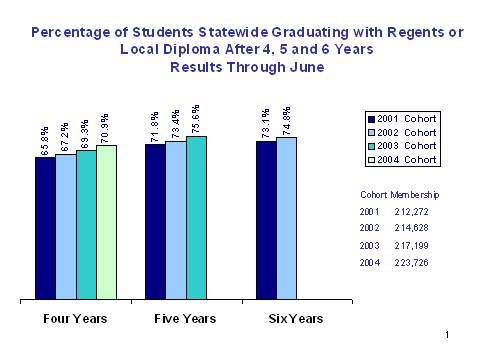
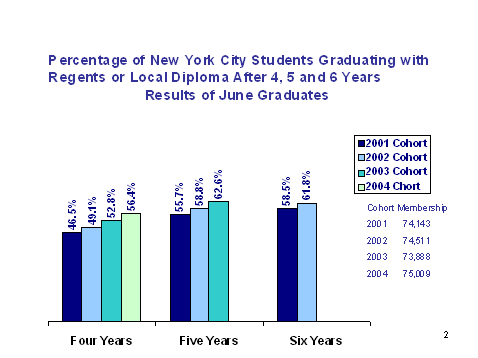
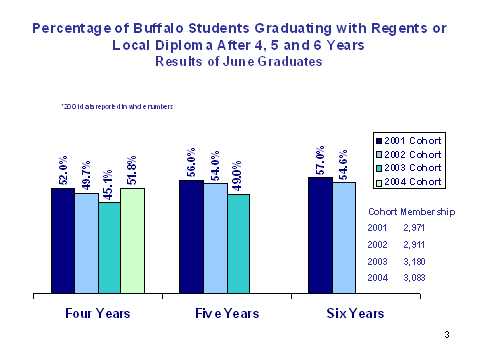
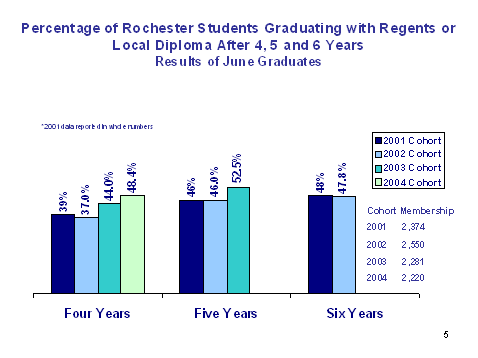
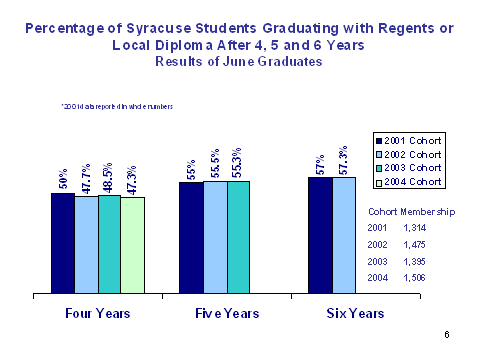
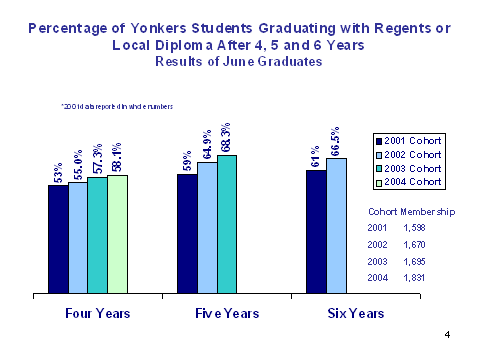
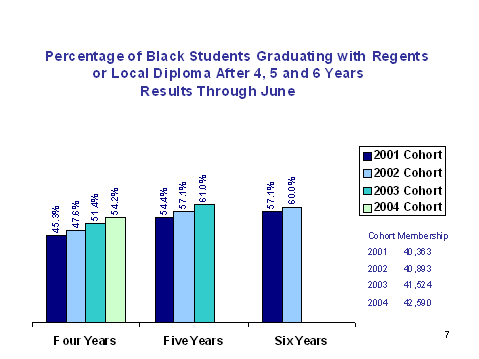
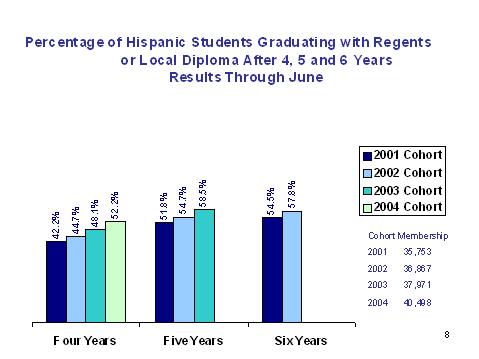
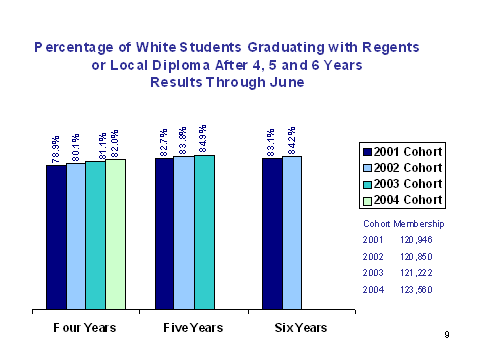
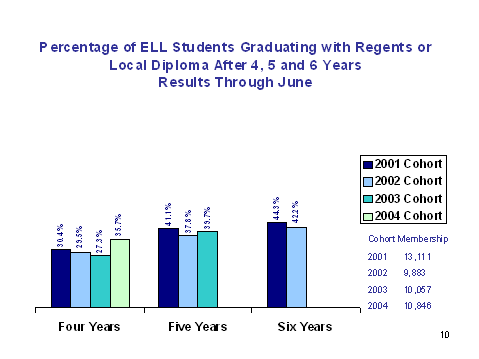
As illustrated above, use of an extended five or six year graduation rate is an important factor for students such as those with disabilities and English language learners who may need more time to earn the credits and pass the State assessments required for high school graduation. Policy should support a school district's efforts to provide additional time for students to earn a high school diploma.
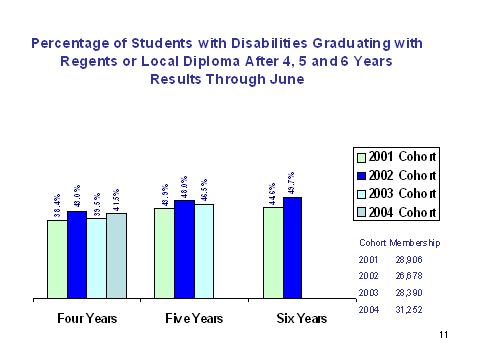
Policy Options for Consideration
If the Regents choose to implement an extended year graduation rate cohort, they must decide how the extended graduation rate will be used in combination with the four year graduation rate for making AYP decisions. If the Regents decide to use an extended year cohort, they can decide to give schools and districts credit for making AYP so long as the school or district achieves the goal or the target(s) on either the four year cohort or the extended year cohort or create an index that combines the four year and the extended year graduation rates and use that as the basis for AYP determinations.
Giving schools and districts credit for making AYP by achieving either the four year adjusted rate graduation rate goal or targets or the extended-year goal or targets is straightforward, easy to understand, and beneficial to the ability of schools and districts to make AYP. Creating an index, while more complicated, allows the state to continue to give greater weight to the success of schools and districts in having students graduate in four years while also giving schools and districts some credit for students who graduate in more than four years.
Under the phase-out of the local diploma enacted by the Regents in 2005, students with disabilities continue to have the option of receiving a local diploma if they pass one or more of the required Regents examinations with a score of 55 or higher.
Under the phase-out of the local diploma enacted by the Regents in 2005, students with disabilities continue to have the option of receiving a local diploma.






 THE STATE EDUCATION DEPARTMENT / THE UNIVERSITY OF THE STATE OF NEW YORK / ALBANY, NY 12234
THE STATE EDUCATION DEPARTMENT / THE UNIVERSITY OF THE STATE OF NEW YORK / ALBANY, NY 12234